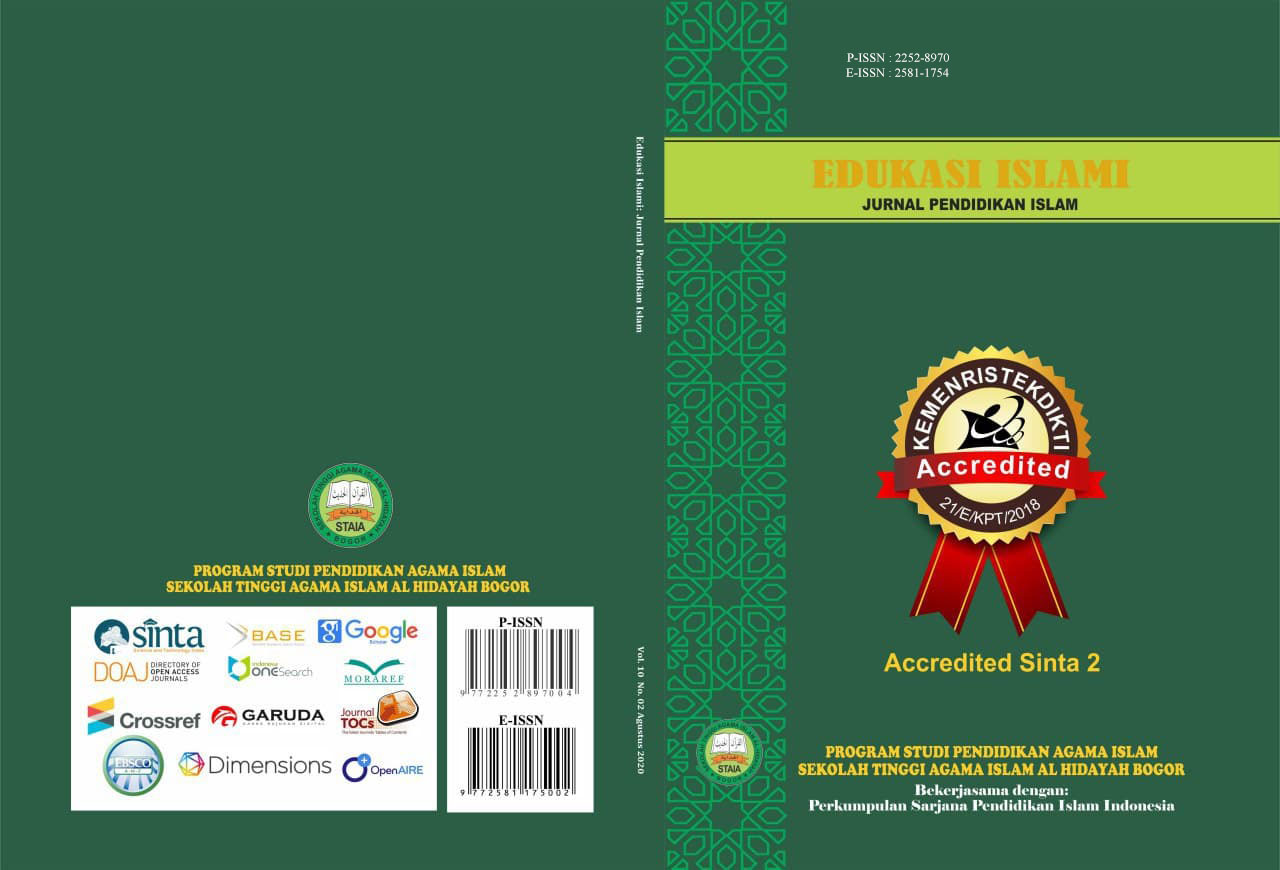Implementation of Independence Character Education in Madrasah
DOI:
https://doi.org/10.30868/ei.v11i01.2274Keywords:
Implementation, Character Education, IndependenceAbstract
This study aims to explore information related to the implementation of self-reliance character education through the creation of a school climate in Madrasah Tsanawiyah Dayah Darul Huda, Langsa City. Through this research, it is hoped that various policies and strategies carried out by Madrasah Tsanawiyah will be found in an effort to internalize the values of the character of independence through the creation of a school climate.This research is a descriptive research with a qualitative approach. Data collection techniques used in this study were observation, interviews, and documentation. The technique of checking the validity of the data used is the method triangulation technique. The analytical technique used in this research is inductive analysis technique, which is an analysis that starts from the data and leads to general conclusions. The steps of data analysis include: data reduction, unitization and categorization, data display, and drawing conclusions. The findings in the study show the following results: first, that in the context of implementing self-reliance character education in Madrasah Tsanawiyah Dayah Darul Huda Langsa City has a policy to build independence in students (santri) both independence in terms of learning, self-regulation independence, independence in managing time while students are in the Madrasah environment. Second, in an effort to implement independence character education in the learning process the teacher uses the following strategies: 1) assignments that require students to independently utilize existing learning resources in the dayah and madrasah environment, 2) make learning contracts, and 3) integrate independence character education in the learning process. teaching and learning in the classroom. Third, related to the obstacles experienced by madrasas in implementing independence character education, namely the lack of consistency of parents, and the presence of several teachers who have not integrated independence character education in the learning process.
References
Abuddin Nata, Manajemen Pendidikan, Mengatasi Kelemahan Pendidikan Islam di Indonesia, Cet. Ke-III ( Jakarta: Prenada Media Group, 2003).
Arikunto, S. Prosedur penelitian suatu pendekatan dan praktek. (Jakarta: Rineka Cipta, 1998).
Al Musanna, Revitalisasi Kurikulum Muatan Lokal Untuk Pendidikan Karakter Melalui Evaluasi Responsif, Jurnal Pendidikan dan Kebudayaan Volume 16 Edisi khusus III, Oktober 2010, Balitbang Kementerian Pendidikan Nasional.
Bebeau, M.J., Rest, J.R., & Narvaez, D. Beyond the promise: a perspective on research in moral education. Educational Reasearcher. 28 (18), 1999, h.18-26.
Bambang Q-Annes & Adang Hambali, Pendidikan Karakter Berbasis Qur’ani (Bandung: Simbiosa Rekatama Media, 2008),
Berry, R. S., 100 Ideas that work discipline in the classroom. (Philipines: ACSI Publications, 1994).
Budimansyah, D. & Sapriya. Refleksi implementasi project citizen dalam pembelajaran pendidikan kewarganegaraan di Indonesia. Dalam Budimansyah, D. (Penyunting). Dimensi-dimensi praktik pendidikan karakter. (Bandung: Widya Aksara Pers, 2012).
Dupper, D. R. A new model of school discipline engaging students and preventing behavior problems. (Oxford University Press, New York, 2010)
Donni Koesoema A, Pendidikan Karakter di Zaman Keblinger, Mengembangkan Visi Guru Sebagai Pelaku Perubahan dan Pendidikan Karakter ( Jakarta: Grasindo, 2009)
Effendi, N.M. Pengembangan karakter cerdas melalui pembinaan kesantunan berbahasa dalam pembelajaran bahasa Inggris di SMP. Dalam Budimansyah, D. (Penyunting). Dimensi-dimensi praktik pendidikan karakter. (Bandung: Widya Aksara Pers, 2012).
Glanzer, P. L, & Milson, A. J. Legislating the good : a survey and evaluation of character education laws in the United States. Educational Policy, 20 (3), 2006, h. 525-550.
Hilda Ainissyifa, Pendidikan Karakter dalam Perspektif Pendidikan Islam, Jurnal Pendidikan Universitas Garut, Vol. 08, No. 01, 2014, h. 1-26
Kirschenbaum, H. 100 ways to enhance values and morality in schools and youth setting. (London: Allyn and Bacon, 1995).
Lickona, T. Educating for character. (New York: Bantam Books, 1994)
Masnur Muslich, Pendidikan Karakter, Menjawab Tantangan Krisis Multidimensional (Jakarta: Bumi Aksara, 2011)
Maharani Ramadhanti, M Syarif Sumantri & Edwita, Pembentukan Karakter Dalam Pembelajaran Bcct (Beyond Center And Circle Time), Jurnal Educate, Vol. 4, No. 1 Januari 2019, h. 9-17
Moleong, L. Metode penelitian kualitatif. (Bandung: Remaja Rosda Karya, 2007)
Nucci, L. P., & Narvaez, D. Handbook of moral and character education. (New York: Routledge, 2008).
Nur Uhbiyati. Ilmu Pendidikan Islam. (Bandung: Pustaka Setia.2005).
Nurchaili, Membangun Karakter Siswa Melalui Keteladanan Guru, Jurnal Pendidikan dan Kebudayaan Volume 16 Edisi khusus III, Oktober 2010, Balitbang Kementerian Pendidikan Nasional
Suparno, P. Harapan untuk kurikulum baru. (Kompas, 21 januari 2012).
Sri Judiani, Implementasi Pendidikan Karakter di Sekolah Dasar Melalui Pengamatan Pelaksaan Kurikulum, Jurnal Pendidikan dan Kebudayaan Volume 16 Edisi khusus III, Oktober 2010, Balitbang Kementerian Pendidikan Nasional.
Watson, M. Developmental discipline and moral education.Dalam Nucci, LP.,& Narvaez, D. (Penyunting). Handbook of moral and character. (New York: Routledge, 2008).
Wuryandani, W. Internalisasi Nilai Karakter Disiplin di Sekolah Dasar (Hubungan Keterlibatan Orang Tua, Komite Sekolah, dan Iklim Kelas yang Kondusif Dengan Sikap Disiplin Siswa di SD Muhammadiyah Sapen Yogyakarta). Disertasi Sekolah Pascasarjana UPI: tidak diterbitkan, 2014
Wynne, E. A. (1991). Character and Academics in The Elementary School.DalamBenninga J.S. (Penyunting). Moral, character, and civic education in the elementary school. (New York: Teachers College, Columbia University, 1991).
Wynne, EA (1991). Character and Academics in The Elementary School. In Benninga JS (Editor). Moral, character, and civic education in the elementary school. (New York: Teachers College, Columbia University, 1991).
Downloads
Additional Files
Published
Issue
Section
Citation Check
License
Authors who publish with this journal agree to the following terms:
- Authors retain copyright and grant the journal right of first publication with the work simultaneously licensed under a Creative Commons Attribution License that allows others to share the work with an acknowledgment of the work's authorship and initial publication in this journal.
- Authors are able to enter into separate, additional contractual arrangements for the non-exclusive distribution of the journal's published version of the work (e.g., post it to an institutional repository or publish it in a book), with an acknowledgment of its initial publication in this journal.
- Authors are permitted and encouraged to post their work online (e.g., in institutional repositories or on their website) prior to and during the submission process, as it can lead to productive exchanges, as well as earlier and greater citation of published work (See The Effect of Open Access).









